In honour of the symposium Literary, religious and manuscript cultures of the German-speaking lands: a symposium in memory of Nigel F. Palmer (1946-2022) on 19/20 May 2023, St Edmund Hall librarian James Howarth set up an exhibition in the Old Library of books related to the late Professor Nigel F. Palmer’s research, his activities and his own scholarship.
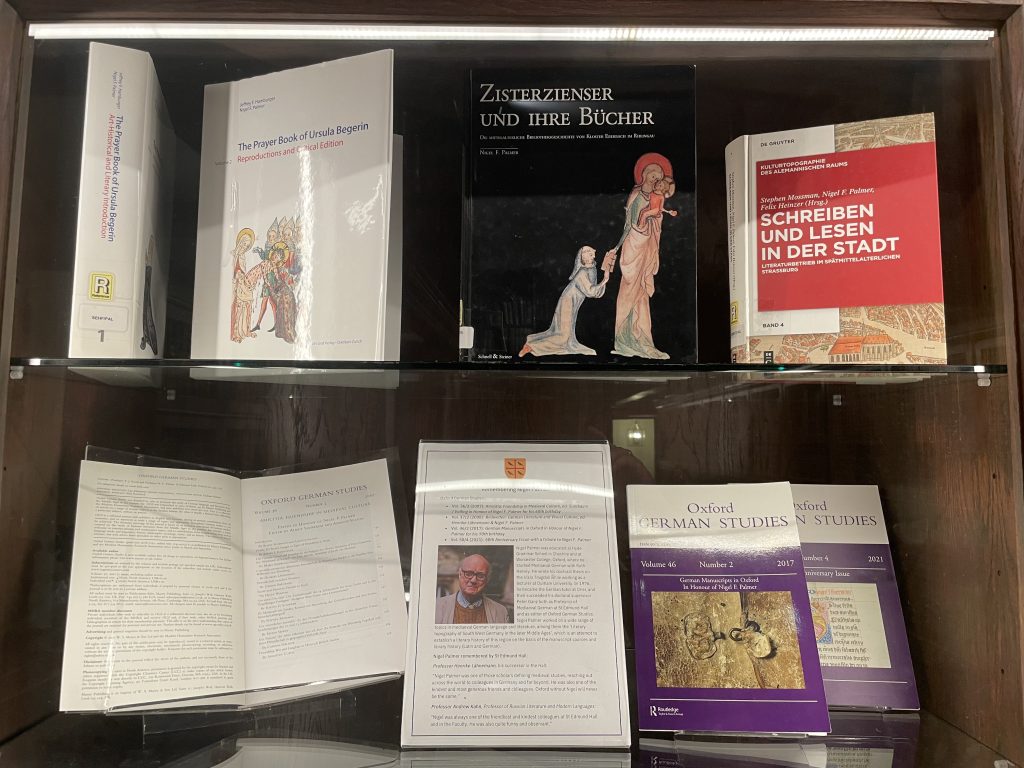
Nigel Palmer was Library Fellow and Old Library Fellow at St Edmund Hall from 2012-2015. He was a great champion of both libraries, especially of the 17th century Old Library.
During his tenure, the antiquarian collection held in the Old Library was catalogued in full, made available on SOLO, the University of Oxford library catalogue. and a start was made on fundraising for the refurbishment of the room including the installation of environmental controls. This work was undertaken in 2018-19 and has helped ensure the preservation of the collection while also giving us greater means for the display of books. Above all, Nigel, as he wrote in the Hall Magazine in his final year as Library Fellow, was concerned to ensure “the paramount function of the Old Library as part of the working library”. An ambition that underlies all the work we undertake with the historic collections of the College.
1: A Pilgrimage to the Holy Land
One of three books in the Hall’s collection published before 1501, this is a lavishly illustrated account of a pilgrimage to Jerusalem. The woodcuts were created from drawings made along the way. Our copy is sadly incomplete; the full version of this illustration, of a war galley of the Knights of John of Jerusalem sailing into harbour in Rhodes, should fold out to be 4 sheets long but only a single sheet remains. The book was previously owned by Augustine Steward who was mayor of Norwich in the 1530s at the height of the Reformation.
Bernhard von, Breydenbach, Peregrinatio in Terram Sanctam (Speyer, 1490) – Open at illustration of Rhodes harbour with hand drawn initials on facing page.
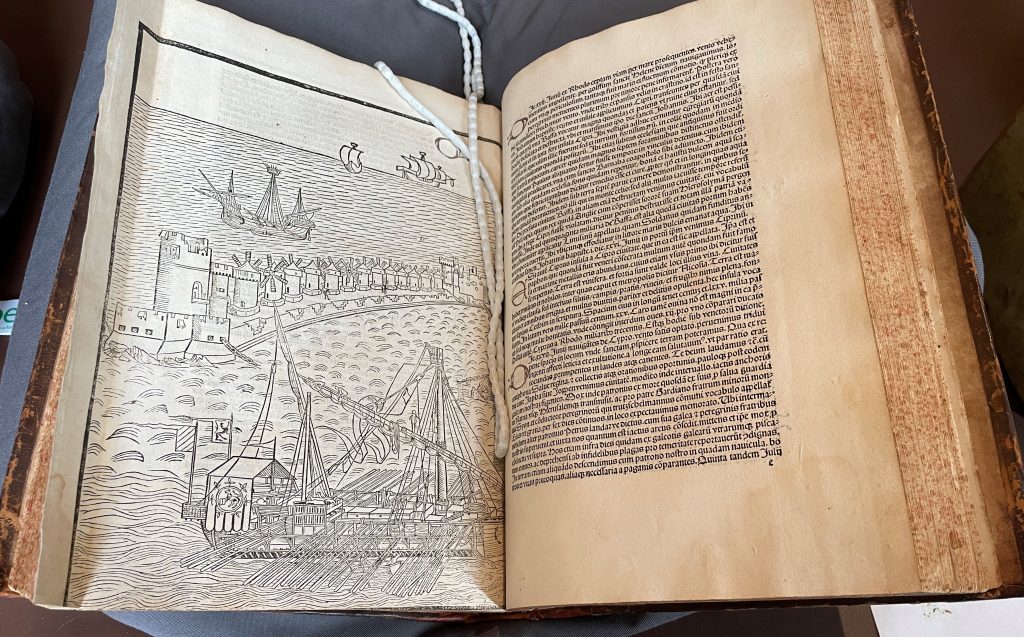
2: Medieval books printed in Germany
This treatise on holy water is the oldest book in the Old Library Collection.
It was written by the Spanish Cardinal Juan de Torquemada, uncle of the more (in)famous Tomas, the first Grand Inquisitor of the Spanish Inquisition. This gives the book a further retrospective link to the Hall. Amongst our alumni is Terry Jones (mat. 1962) who, with Michael Palin, wrote the ‘nobody expects the Spanish Inquisition’ sketch for Monty Python. It was presented to the Library in 1931 by AB Emden (Principal, 1922-1951).
The Legenda Aurea (Golden Legend) was an immensely popular compilation of saints’ lives compiled by the Dominican Jacobus de Voragine in the 13th century. More than a thousand manuscript survive, as well as innumerable printed editions and translations across Europe. This copy printed in Strasburg in 1496 is one of three incunabula (books printed before 1500) held by St Edmund Hall. Our copy was given by Ernest F. Salmon in 1957 in memory of his son Gilbert Salmon (mat. 1913) who died in Iran in 1920 while serving in the British Army.
Juan de Torquemada, Incipit tractatus de efficacia aque benedicte (Augsburg, 1476) – Open at Incipit J 142
Jacob de Voraigne, Lombardica hystoria (Strasburg, 1496)
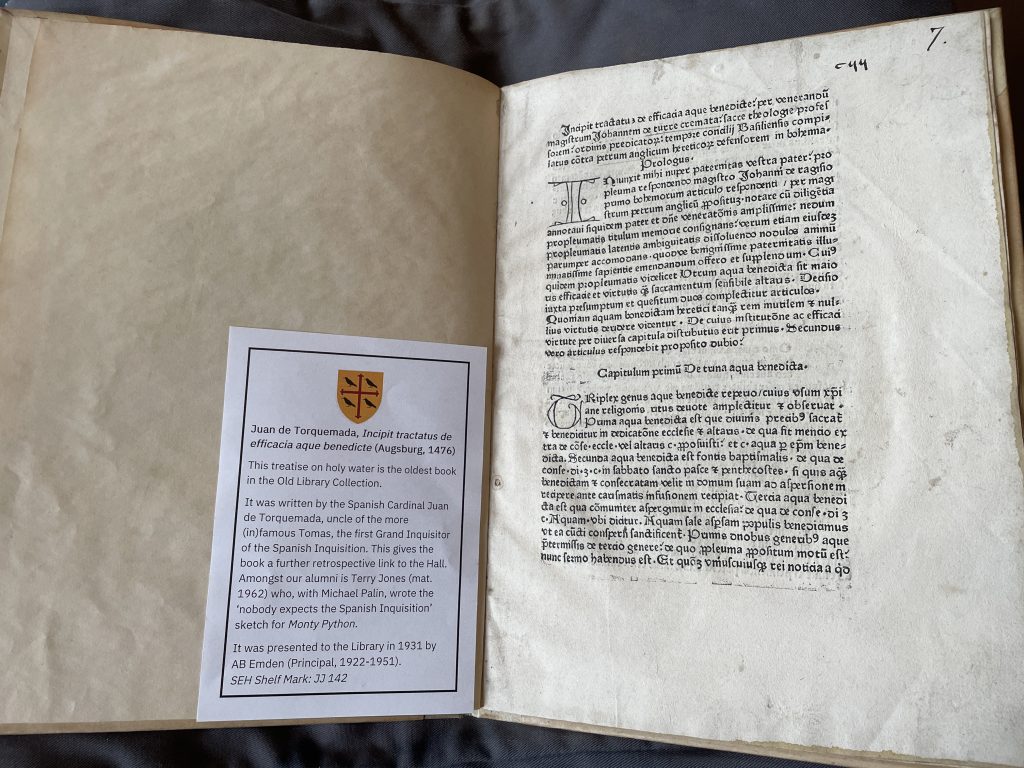
3: The first work in German on geography
The Cosmographia was the first geographical work written in German. It was immensely successful going through 19 editions between 1544 and 1628. It was also translated into several other languages. Our copy is the first Latin edition of 1550. It is a wide-ranging and beautifully illustrated work containing realistic renderings of cities in Europe (as here Freiburg), but also fantastical and grotesque illustrations of sea monsters to be found of the coast of Greenland and monopods and men with heads in their chests in the section on Asia.
Sebastian Münster, Cosmographiae uniuersalis lib. VI. in quibus, iuxta certioris fidei scriptorum traditionem describuntur (Basel, 1550) – Open at the double spread on pp. 548/549 with Freiburg im Breisgau
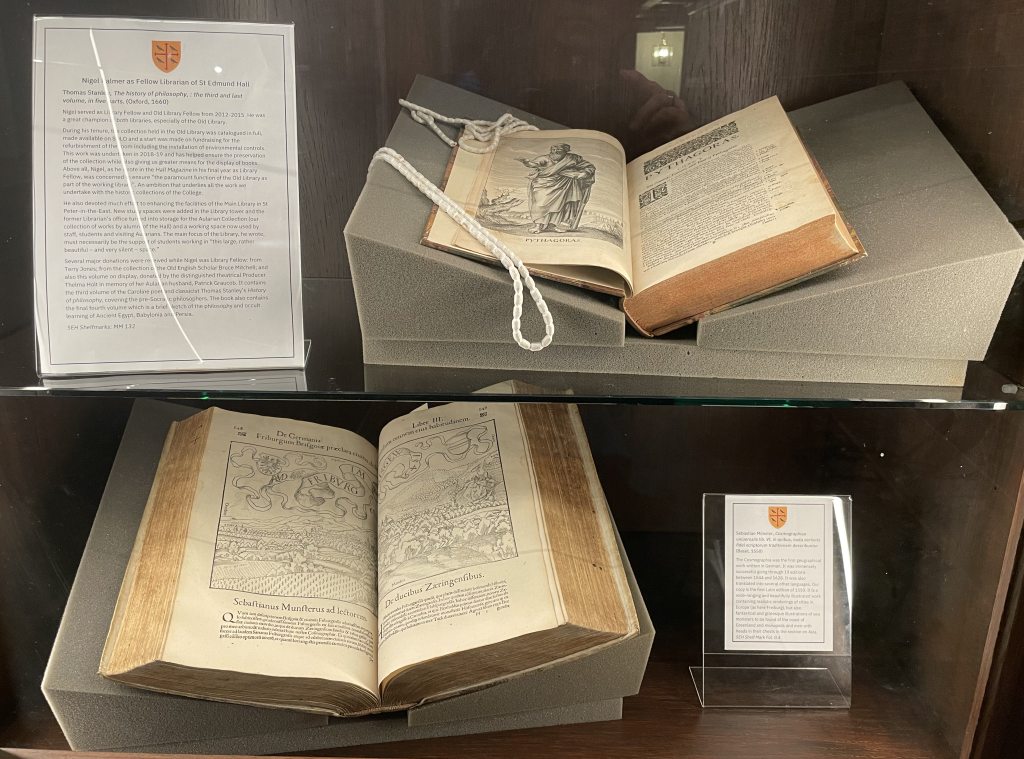
4: Fine German Bindings of the 16th century
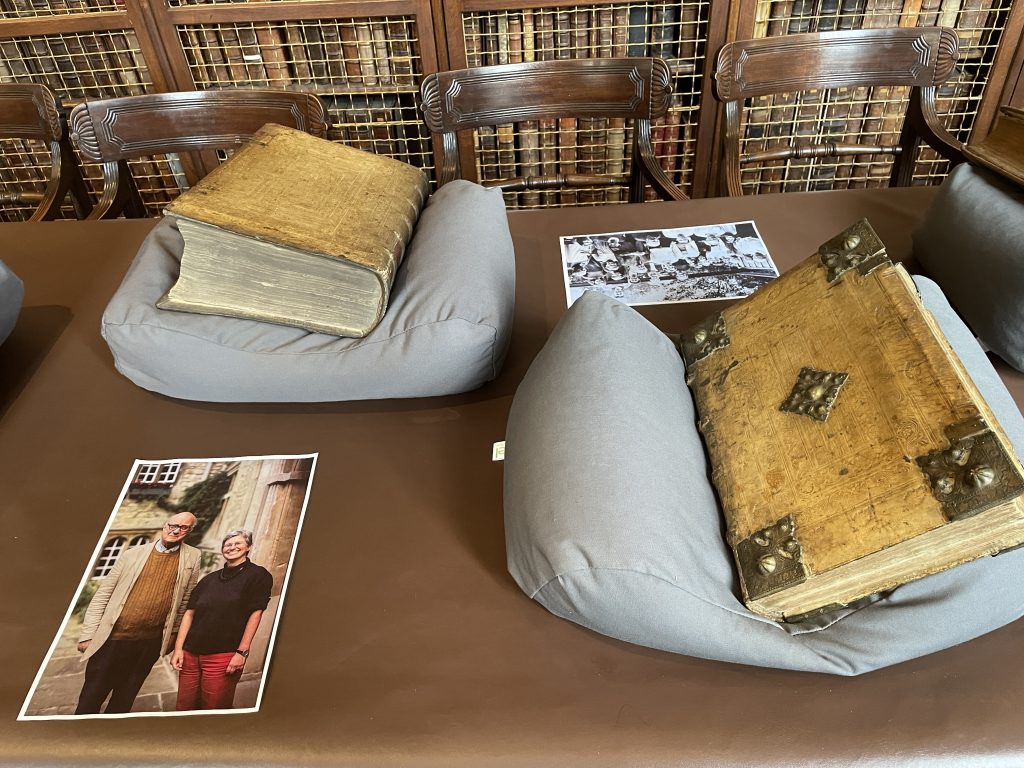
Theodore Beza, Theodori Bezae Vezelii, Volumen tractationum theologicarum (Geneva, 1576) – Our copy of the works of the Swiss Theologian Theodore Beza is bound in allum-tawed pigskin over wooden boards, tooled in blind with roll-tools, including scenes of the Resurrection (“mors era mo | rs tva mors“), Crucifixion (“Ecce agnvs | Dei qvi toll“), Annunciation (“Concipies in | vtero et par”) and Baptism (“Hic est fili | mevs dilec“) signed “H W” on the grave in the Resurrection image and “F H” on a book in the Baptism.
Beatus Rhenanus, Rerum Germanicarum libri tres (Basel, 1531)
Nouus orbis regionum ac insularum ueteribus incognitarum (Basel, 1532) – These two important works, one printed by Hieronymus Froben – perhaps the most important scholar-printer of his time – are preserved together in a fine binding of pigskin decorated with a blind-tooled thistle pattern and brass clasps. Its condition is also exceptional, as if it ‘has not been tampered with since it left the binder’s workshop shortly after [it was] printed’ wrote Dr Paul Nash who catalogued the Old Library. Nouus orbis regionum ac insularum ueteribus incognitarum is one of the earliest compendiums of travel and exploration, with 17 accounts on the discoveries, in America and Southeast Asia, by Marco Polo, Columbus, Amerigo Vespucci etc.
Matthias Flaccius et al, Ecclesiastica historia (Basel, 1554-74) – This work, commonly known in English as ‘The Magdeburg Centuries’ is the first great work of ecclesiastical church History. Lutheran theologian Werner Elert described it as the basis of all modern church history. They are bound in blind-tooled allum-tawed pigskin and a roll with potraits of “Prvde[ntia]”, “Lvcre[cia]”, “Ivstic[ia]”, “Svavit[as]” signed “H K”. Each volume has a striking central panel on both sides of the book depicting Biblical scenes of men betrayed or defeated by women. The front boards all bearing scenes of Samson slaying the lion and with Delilah. The back boards have a single scene of Jael killing Sisera with the caption ‘Sic pereant omnes inimici tvi domini Ivdicvm: v:’ or Salome with the head of John the Baptist with the caption ‘Volvntatim timentiv esse faciet Dominvs psalmo 185’. The volumes are further stamped with the owner’s initials ‘P G E’ and the date
5: History of Books & Printing
The early history of the printed book (especially blockbooks) was one of Nigel’s research interests. As it happens the oldest work in German in the collection is also a work of bibliographic history. It was donated by Stephen Penton, the Principal of the Hall who was responsible for the Library’s construction, and has been on the shelves since the Library was built in the 1680s.
The book part of a three-volume work compiled from the catalogues of the Frankfurt book fair detailing all the books published in Europe up to 1625. Draud’s work is particularly valued by musicologists as it concerns much more extensive details of musical works than other earlier bibliographic collections.
Adam Melchior, Rector of Heidelburg University and laureate poet, wrote several volumes of biographies of notable German philosophers, theologians and thinkers. The first volume of the work opens with the startling conjunction of Johannes Gutenberg, the pioneer of printing and Johannes Faust, the semi-legendary source of the demonologist immortalised by Marlowe and Goethe.

Georg Draud, Bibliotheca librorum germanicorum classica, Bibliotheca classica & Bibliotheca exotica. (Frankfurt, 1625)
Melchior Adam, Vitæ Germanorum superiori, et quod excurrit, seculo philosophicis et humanioribus literis clarorum; (Frankfurt, 1615)
7: Early 16th century printed books
The three oldest post-1500 books in the library all relate to interests of Nigel Palmer’s:

St Jerome, Liber aepistolarum Sancti Hieronymi primae partis (Lyon, 1508) shows as title page image a woodcut of Jerome pulling the thorn out of the lion’s paw. He sits at the desk during his translation work with Genesis 1 open in Hebrew, Greek, and his Latin Vulgate translation. This is a copy of the woodcut by the young Albrecht Dürer for a two-volume folio edition of his letters printed in Basel 1492 by Nikolaus Kessler Epistolare beati Hieronymi (GW 12433). A copy of that is in Oxford, Trinity College, Old Library, I.7.1.
St Bernard of Clairvaux, Works (Paris, 1508)
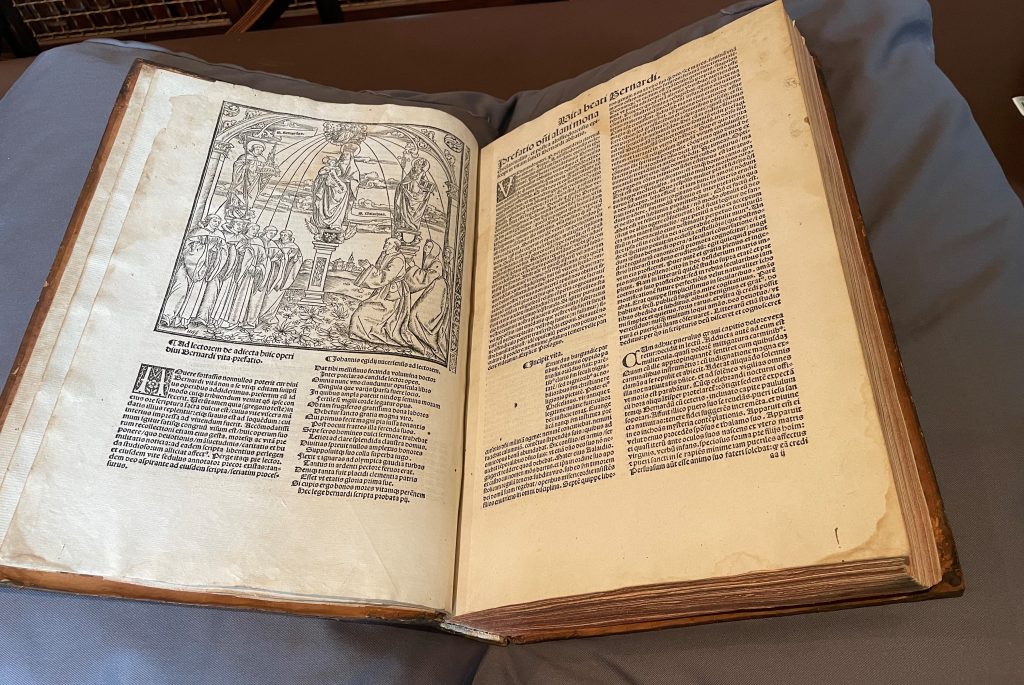
Both the Letters of St Jerome and the Works of St Bernard were donated by a Kentish cleric called Basil Kennett around 1682-84 at the time of the Library’s construction. Kennett’s two sons White (mat. 1678) and Basil (mat. 1689) attended the Hall. He also appears to have organised something of a book drive for the new Library in his local area. In a list of book donors written by Thomas Hearne, Kennett’s donations are followed by those of six other gentry and clergy from Kent who have no other connection to the Hall.
Both of his sons had distinguished careers. White Kennett went on become Vice Principal of Teddy Hall and subsequently Bishop of Peterborough. The younger brother, Basil, became President of Corpus Christi College.
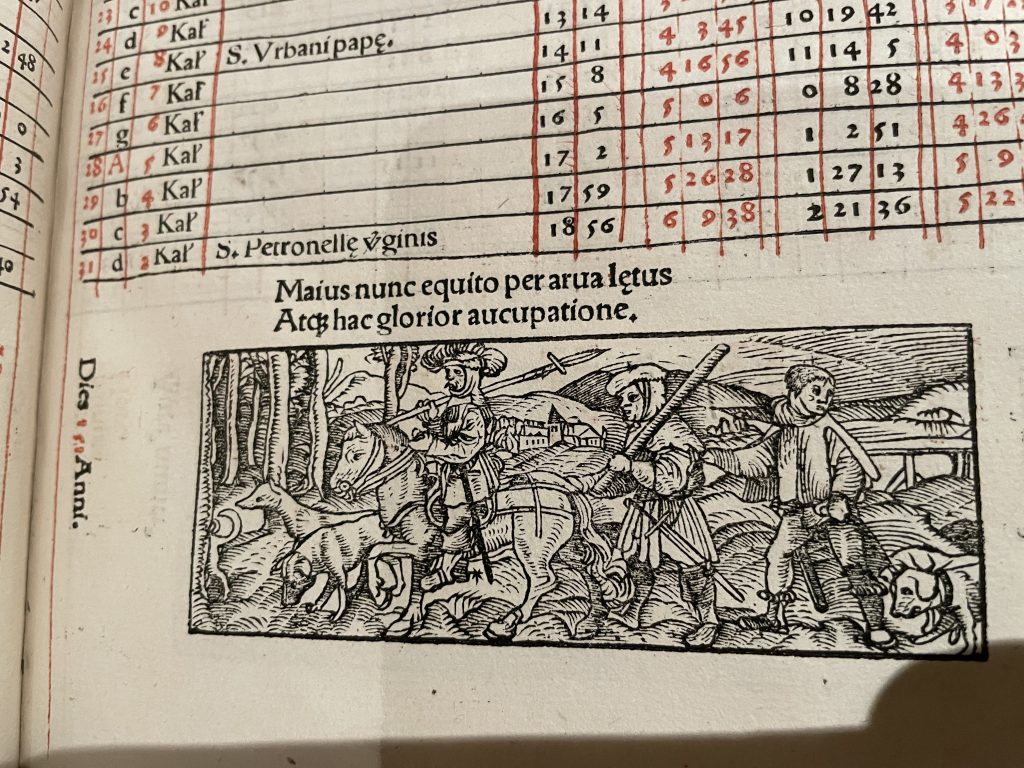
Johan Stoeffler, Calendarium Romanum magnum (Oppenheim, 1518)
The Calendarium Romanum is a Catholic liturgical Calendar.Open at May with agricultural scenes lunar dates etc. It is a grandly presented with the dates of all the major feasts printed in red ink and many wood-cut illustrations. The dates of solar and lunar eclipses are shown through to the 1570s. Although our copy has only about a third of the text and lacks a number of illustrations, it still is a beautiful text.
6: Nigel Palmer as Fellow Librarian
As well as his championing of the Old Library, Nigel also devoted much effort to enhancing the facilities of the Main Library in St Peter-in-the-East. New study spaces were added in the Library tower and the former Librarian’s office turned into storage for the Aularian Collection (our collection of works by alumni of the Hall) and a working space now used by staff, students and visiting Aularians. The main focus of the Library, he wrote, must necessarily be the support of students working in “this large, rather beautiful – and very silent – space.”
Several major donations were received while Nigel was Library Fellow: from Terry Jones; from the collection of the Old English Scholar Bruce Mitchell; and also this volume , donated by the distinguished theatrical Producer Thelma Holt in memory of her Aularian husband, Patrick Graucob. It contains the third volume of the Caroline poet and classicist Thomas Stanley’s History of philosophy, covering the pre-Socratic philosophers. The book also contains the final fourth volume which is a brief sketch of the philosophy and occult learning of Ancient Egypt, Babylonia and Persia.
Thomas Stanley, The history of philosophy, : the third and last volume, in five parts. (Oxford, 1660)

7: Cataloguing the Old Library
The cataloguing of the entire Old Library collection to modern bibliographic standards is the crowning achievement of Nigel’s time as Library Fellow. More than 6,700 records were created, all available in full online via the University’s SOLO catalogue. The records have copy-specific notes describing the unique characteristics of the Old Library’s books including provenance, annotations and details of bindings. This has opened our historic collections to a worldwide audience of academic researchers and has greatly increased their use not only by visiting scholars but also by a growing number of our own students.
The cataloguing uncovered details such as the beautiful hand-coloured title page of this 1518 edition of Erasmus’ Adages. The metal-cut illustration desined b Ambrosius Holbein depicts Classical philosophers from whose work Erasmus extracted many of the proverbs, adages and turns of phrases listed in his work. He periodically re-issued the work and the number of entries had reached over 4,00 by the last edition he oversaw.
The Old Library cataloguing project also made more formal bibliographic discoveries such as this probably unique copy of a theological treatise by the Anglican theologian John Bradock (1655-1719). It was written during a controversy in the 1790s on the nature of the Trinity. It is the second part of The doctrine of the fathers and the schools consider’d: concerning the articles of a Trinity of divine persons and the unity of God which appeared in the first part of 1695. Thomas Tenison, the Archbishop of Canterbury, seeking to end the debate, had the second part suppressed while in it was being prepared for publication. No printed copy was known to survive until our copy was catalogued. It lacks a title page but does include printers’ advertisements at the end, suggesting the work was very close to publication at the time it was censored.
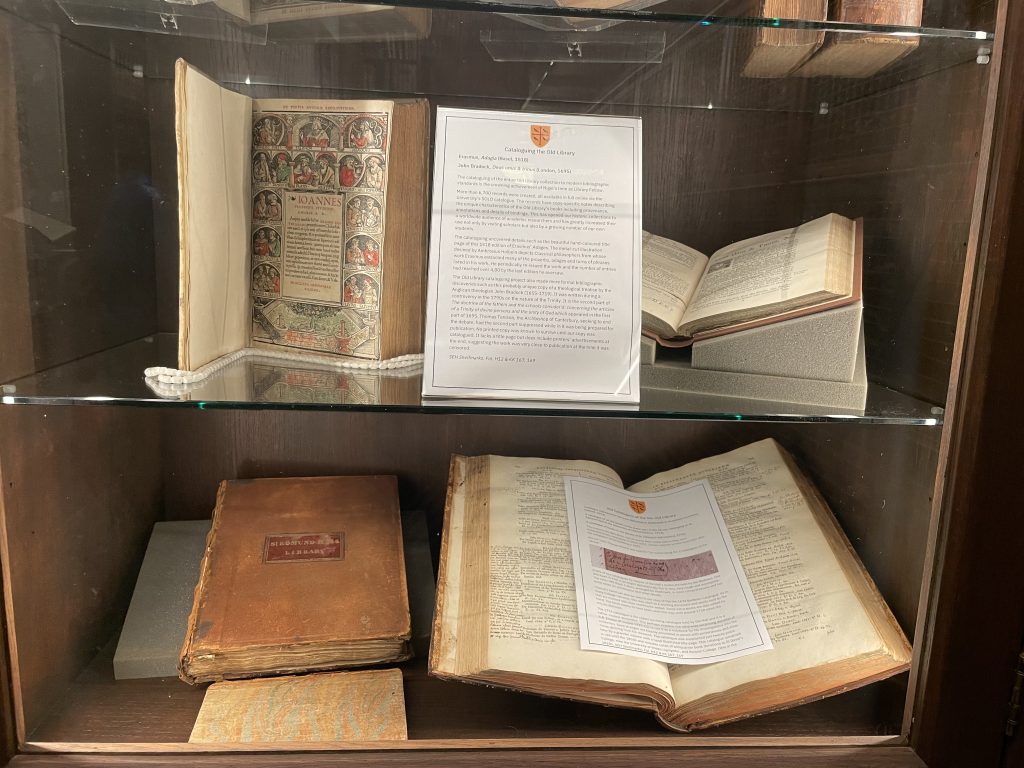
Erasmus, Adagia (Basel, 1518)
Hand coloured title-page designed by Ambrosius Holbein with images of philosophers Fol R 23
John Bradock, Deus unus & trinus (London, 1695).
Otherwise unknown and probably unique second part of a work suppressed before publication. SEH Shelfmarks: Fol. H12 & KK 167, 169
8. Old Old Library Catalogues
Catalogus impressorum librorum Bibliothecæ Bodleianæ in Academia Oxoniensi. (Oxford, 1674)
Printed Bod catalogue that formed the first working catalogue of the OL. Hall books underlined and given shelf mark, first entries by Thomas Hearne. Fol H12
A catalogue of all the books in the lower part of the library, belonging to St. Edmund Hall in the University of Oxford (Oxford, 1774)
MS Library catalogue with pencil annotations by AB Emden – very fragile would need to go in exhibition case probably. KK 167
A catalogue of books in the library of St. Edmund Hall (Oxford, 1792)
Later MS catalogue with hand-drawn decorated title page KK 169
9: Books by and for Nigel
- Nigel Palmer, Zisterzienser und ihre Bücher (Regensburg, 1998)
- Nigel Palmer, Schreiben und lesen in der Stadt (Berlin, 2012)
- Nigel Palmer, The prayer book of Ursula Begerin (Zurich, 2015)
- Nigel Palmer, Das Münchner Gedicht von den fünfzehn Zeichen vor dem Jüngsten Gericht (
Special Issues of Oxford German Studies:
Vol. 36/2 (2007): Amicitia: Friendship in Medieval Culture, ed. Suerbaum / Volfing for 60th birthday
Vol. 37/2 (2008): Bildwelten: German Literature and Visual Culture, ed. Lähnemann / Palmer
Vol. 46/2 (2017): German Manuscripts in Oxford in Honour of Nigel F. Palmer for 70th birthday
Vol. 50/4 (2021): 50th Anniversary Issue with a tribute to Nigel F. Palmer
10: Chained books
The Old Library retains three chained books that show how books would have been stored when the Library was built. Books were displayed upright with the spines at the back (the reverse of today), shelf marks were written on the front edge of the pages. All books were ‘chained’ attached by chains ending in a ring to a bar at the back of the shelf. They could not be removed unless the bar was unlocked.
Teddy Hall was one of the last colleges to abandon chaining in the 1760s. Thethree books appear in early Library catalogues and have probably been in their present position on the shelves since they arrived in the Library in the late 17th century.
We do have a small confession though – these chains are not the originals! They were acquired from St John’s College in the 1930s and reattached to the books.
- Gerardus Vossius, De theologia gentili, et physiologia Christiana (Amsterdam, 1668)
- Livy, Titi Liuii Patauini Historiæ Romanæ ab vrbe condita (Paris, 1573)
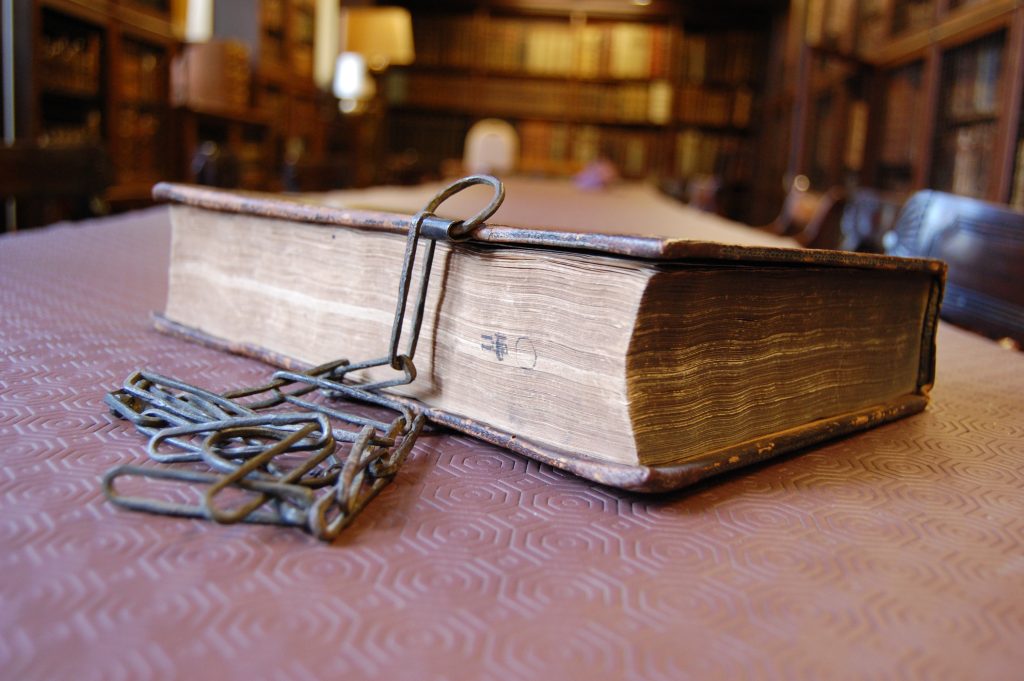
On view in the front the three German incunables of the collection, further down on the table the early 16th century books, in the display cabinet books publications by Nigel Palmer and relating to his activities as Library Fellow such as old catalogues.


1 thought on “Nigel Palmer as Library Fellow at St Edmund Hall”